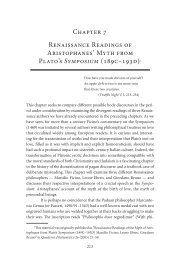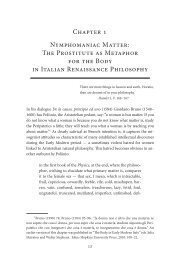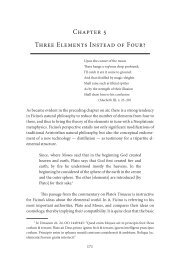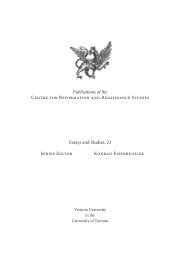Chapter 2 Matter as a Mirror: Marsilio Ficino and Renaissance ...
Chapter 2 Matter as a Mirror: Marsilio Ficino and Renaissance ...
Chapter 2 Matter as a Mirror: Marsilio Ficino and Renaissance ...
Create successful ePaper yourself
Turn your PDF publications into a flip-book with our unique Google optimized e-Paper software.
<strong>Matter</strong> <strong>as</strong> a <strong>Mirror</strong> 85<br />
by maintaining that the soul’s image is reflected in the physical world, though<br />
in a deceptive way. “[This lower part of the soul] is pictured <strong>as</strong> being present<br />
in bodies since it shines into them <strong>and</strong> makes living creatures, but not of itself<br />
<strong>and</strong> body, but abiding itself <strong>and</strong> giving images of itself, like a face seen in<br />
many mirrors.” 120 According to Plotinus, matter reflects soul in many different<br />
images, but without ever entering into union with soul. Hence, in Plotinus,<br />
the mirror is a metaphor signifying detachment, <strong>as</strong> opposed to communication<br />
or sexual union. <strong>Ficino</strong> sometimes uses the mirror in an analogous way:<br />
for instance, when he compares the way the mind perceives corporeal beings<br />
to the reflection of the flame of a c<strong>and</strong>le in the mirror where the fire is not hot.<br />
In a way reminiscent of celestial fire (which lacks heat), this is an instant in<br />
which the lower (the body of the c<strong>and</strong>le’s coarse material flame) is subsumed<br />
by a higher potency (mind) <strong>and</strong> purified <strong>and</strong> de-materialised in the process.<br />
Yet, in accordance with the <strong>as</strong>cent towards the divine so characteristic<br />
of Neoplatonic philosophies in general, the process may also work the<br />
other way around: instead of conveying the idea or the image of deception<br />
<strong>and</strong> deterioration, the mirror may focus divine influx. Quite unexpectedly,<br />
<strong>Ficino</strong> sometimes even maintains that the rays of common light are “restored<br />
<strong>and</strong> illuminated” in the mirror:<br />
Indeed, so great is the “friendship” of light for the mirror that<br />
lights <strong>and</strong> visual rays <strong>and</strong> radial images are not dissipated or<br />
weakened in it, but immediately enhanced <strong>and</strong> strengthened.<br />
Thus intensified, […] the light instantly illuminates a wall<br />
opposite. 121<br />
In several other instances <strong>Ficino</strong> maintains that the light that falls<br />
onto a body is collected there <strong>and</strong> (presumably after a certain time) reinvigorates<br />
again, especially in bodies that are congruous to it. Then the light starts<br />
to redirect itself in the opposite direction, just <strong>as</strong> a mirror c<strong>as</strong>ts light “on the<br />
opposite wall <strong>and</strong> creates splendour there.” Thus, the light first orders this<br />
120 Enneads I, 8 15–17.<br />
121 In Timaeum def. 30, OO 473: “Tanta profecto amicitia luminis est ad speculum,<br />
ut in hoc ipso lumina radii visuales, radiales imagines non infrangantur quidem, sed ita<br />
protinus invalescant, ut hinc statim multiplicatum lumen oppositum illuminet parietem,<br />
[…].” See Allen (1989) 185.







